- Desk Research: Definition, Types, Application, Pros & Cons

If you are looking for a way to conduct a research study while optimizing your resources, desk research is a great option. Desk research uses existing data from various sources, such as books, articles, websites, and databases, to answer your research questions.
Let’s explore desk research methods and tips to help you select the one for your research.

What Is Desk Research?
Desk research, also known as secondary research or documentary research, is a type of research that relies on data that has already been collected and published by others. Its data sources include public libraries, websites, reports, surveys, journals, newspapers, magazines, books, podcasts, videos, and other sources.
When performing desk research, you are not gathering new information from primary sources such as interviews, observations, experiments, or surveys. The information gathered will then be used to make informed decisions.
The most common use cases for desk research are market research , consumer behavior , industry trends , and competitor analysis .
How Is Desk Research Used?
Here are the most common use cases for desk research:
- Exploring a new topic or problem
- Identifying existing knowledge gaps
- Reviewing the literature on a specific subject
- Finding relevant data and statistics
- Analyzing trends and patterns
- Evaluating competitors and market trends
- Supporting or challenging hypotheses
- Validating or complementing primary research
Types of Desk Research Methods
There are two main types of desk research methods: qualitative and quantitative.
- Qualitative Desk Research
Analyzing non-numerical data, such as texts, images, audio, or video. Here are some examples of qualitative desk research methods:
Content analysis – Examining the content and meaning of texts, such as articles, books, reports, or social media posts. It uses data to help you identify themes, patterns, opinions, attitudes, emotions, or biases.
Discourse analysis – Studying the use of language and communication in texts, such as speeches, interviews, conversations, or documents. It helps you understand how language shapes reality, influences behavior, constructs identities, creates power relations, and more.
Narrative analysis – Analyzing the stories and narratives that people tell in texts, such as biographies, autobiographies, memoirs, or testimonials. This allows you to explore how people make sense of their experiences, express their emotions, construct their identities, or cope with challenges.
- Quantitative Desk Research
Analyzing numerical data, such as statistics, graphs, charts, or tables.
Here are common examples of quantitative desk research methods:
Statistical analysis : This method involves applying mathematical techniques and tools to numerical data, such as percentages ratios, averages, correlations, or regressions.
You can use statistical analysis to measure, describe, compare, or test relationships in the data.
Meta-analysis : Combining and synthesizing the results of multiple studies on a similar topic or question. Meta-analysis can help you increase the sample size, reduce the margin of error, or identify common findings or discrepancies in data.
Trend analysis : This method involves examining the changes and developments in numerical data over time, such as sales, profits, prices, or market share. It helps you identify patterns, cycles, fluctuations, or anomalies.
Examples of Desk Research
Here are some real-life examples of desk research questions:
- What are the current trends and challenges in the fintech industry?
- How do Gen Z consumers perceive money and financial services?
- What are the best practices for conducting concept testing for a new fintech product?
- Documentary on World War II and its effect on Austria as a country
You can use the secondary data sources listed below to answer these questions:
Industry reports and publications
- Market research surveys and studies
- Academic journals and papers
- News articles and blogs
- Podcasts and videos
- Social media posts and reviews
- Government and non-government agencies
How to Choose the Best Type of Desk Research
The main factors for selecting a desk research method are:
- Research objective and question
- Budget and deadlines
- Data sources availability and accessibility.
- Quality and reliability of data sources
- Your data analysis skills
Let’s say your research question requires an in-depth analysis of a particular topic, a literature review may be the best method. But if the research question requires analysis of large data sets, you can use trend analysis.
Differences Between Primary Research and Desk Research
The main difference between primary research and desk research is the source of data. Primary research uses data that is collected directly from the respondents or participants of the study. Desk research uses data that is collected by someone else for a different purpose.
Another key difference is the cost and time involved. Primary research is usually more expensive, time-consuming, and resource-intensive than desk research. However, it can also provide you with more specific, accurate, and actionable data that is tailored to your research goal and question.
The best practice is to use desk-based research before primary research; it refines the scope of the work and helps you optimize resources.
Read Also – Primary vs Secondary Research Methods: 15 Key Differences
How to Conduct a Desk Research
Here are the four main steps to conduct desk research:
- Define Research Goal and Question
What do you want to achieve with your desk research? What problem do you want to solve or what opportunity do you want to explore? What specific question do you want to answer with your desk research?
- Identify and Evaluate Data Sources
Where can you find relevant data for your desk research? How relevant and current are the data sources for your research? How consistent and comparable are they with each other?
You can evaluate your data sources based on factors such as-
– Authority: Who is the author or publisher of the data source? What are their credentials and reputation? Are they experts or credible sources on the topic?
– Accuracy: How accurate and precise is the data source? Does it contain any errors or mistakes? Is it supported by evidence or references?
– Objectivity: How objective and unbiased is the data source? Does it present facts or opinions? Does it have any hidden agenda or motive?
– Coverage: How comprehensive and complete is the data source? Does it cover all aspects of your topic? Does it provide enough depth and detail?
– Currency: How current and up-to-date is the data source? When was it published or updated? Is it still relevant to your topic?
- Collect and Analyze Your Data
How can you collect your data efficiently and effectively? What tools or techniques can you use to organize and analyze your data? How can you interpret your data with your research goal and question?
- Present and Report Your Findings
How can you communicate your findings clearly and convincingly? What format or medium can you use to accurately record your findings?
You can use spreadsheets, presentation slides, charts, infographics, and more.
Advantages of Desk Research
- Cost Effective
It is cheaper and faster than primary research, you don’t have to collect new data or report them. You can simply analyze and leverage your findings to make deductions.
- Prevents Effort Duplication
Desk research provides you with a broad and thorough overview of the research topic and related issues. This helps to avoid duplication of efforts and resources by using existing data.
- Improves Data Validity
Using desk research, you can compare and contrast various perspectives and opinions on the same topic. This enhances the credibility and validity of your research by referencing authoritative sources.
- Identify Data Trends and Patterns
It helps you to identify new trends and patterns in the data that may not be obvious from primary research. This can help you see knowledge and research gaps to offer more effective solutions.
Disadvantages of Desk Research
- Outdated Information
One of the main challenges of desk research is that the data may not be relevant, accurate, or up-to-date for the specific research question or purpose. Desk research relies on data that was collected for a different reason or context, which may not match the current needs or goals of the researcher.
- Limited Scope
Another limitation of desk research is that it may not provide enough depth or insight into qualitative aspects of the market, such as consumer behavior, preferences, motivations, or opinions.
Data obtained from existing sources may be biased or incomplete due to the agenda or perspective of the source.
Read More – Research Bias: Definition, Types + Examples
- Data Inconsistencies
It may also be inconsistent or incompatible with other data sources due to different definitions or methodologies.
- Legal and Technical Issues
Desk research data may also be difficult to access or analyze due to legal, ethical, or technical issues.
How to Use Desk Research Effectively
Here are some tips on how to use desk research effectively:
- Define the research problem and objectives clearly and precisely.
- Identify and evaluate the sources of secondary data carefully and critically.
- Compare and contrast different sources of data to check for consistency and reliability.
- Use multiple sources of data to triangulate and validate the findings.
- Supplement desk research with primary research when exploring deeper issues.
- Cite and reference the sources of data properly and ethically.
Desk research should not be used as a substitute for primary research, but rather as a complement or supplement. Combine it with primary research methods, such as surveys, interviews, observations, experiments, and others to obtain a more complete and accurate picture of your research topic.
Desk research is a cost-effective tool for gaining insights into your research topic. Although it has limitations, if you choose the right method and carry out your desk research effectively, you will save a lot of time, money, and effort that primary research would require.

Connect to Formplus, Get Started Now - It's Free!
- desk research
- market research
- primary vs secondary research
- research bias
- secondary research
- Moradeke Owa

You may also like:
Projective Techniques In Surveys: Definition, Types & Pros & Cons
Introduction When you’re conducting a survey, you need to find out what people think about things. But how do you get an accurate and...

What is Thematic Analysis & How to Do It
Introduction Thematic Analysis is a qualitative research method that plays a crucial role in understanding and interpreting data. It...
25 Research Questions for Subscription Pricing
After strategically positioning your product in the market to generate awareness and interest in your target audience, the next step is...
Judgmental Sampling: Definition, Examples and Advantages
Introduction Judgment sampling is a type of non-random sampling method used in survey research and data collection. It is a method in...
Formplus - For Seamless Data Collection
Collect data the right way with a versatile data collection tool. try formplus and transform your work productivity today..

What Is Desk Research? Meaning, Methodology, Examples
Apr 4, 2024
10 min. read
Research in the digital age takes many shapes and forms. There are traditional methods that collect first-hand data via testing, focus groups, interviews, and proprietary data. And then there are ways to tap into the time and effort others have put into research, playing “armchair detective” by conducting desk research .
Desk research gives you a shortcut to insights by pulling data from other resources, which is crucial for understanding the customer journey . It takes less time and is more cost-effective compared to conducting primary market research . Most importantly, it can give you the consumer insights you need to make important business decisions.
Let’s explore the official desk research definition along with types of desk research, methodologies, examples, and how to do desk research effectively.
Desk Research Meaning: What is Desk Research?
Advantages and limitations of desk research, desk research methodology and methods, how to conduct desk research effectively, best practices for desk research, applications of desk research, how to conduct desk research with meltwater.
Desk Research definition: Desk research, also known as secondary research or complementary research , involves gathering information and data from existing sources, such as books, journals, articles, websites, reports, and other published materials. Users analyze and synthesize information from already available information.
Companies use desk research at the onset of a project to gain a better understanding of a topic, identify knowledge gaps, and inform the next stages of research. It can also supplement original findings and provide context and background information.
Desk research gives marketers attractive advantages over traditional primary research, but it’s not without its shortcomings. Let’s explore these in more detail.
Desk research advantages
- Quick insights. Conducting interviews, focus groups, panels, and tests can take weeks or even months, along with additional time to analyze your findings. With desk research, you can pull from existing information to gain similar results in less time.
- Cost-effectiveness. Desk market research is usually less expensive than primary research because it requires less time and fewer resources. You don’t have to recruit participants or administer surveys, for example.
- Accessibility. There’s a world of data out there ready for you to leverage, including online databases, research studies, libraries, and archives.
- Diverse sources. Desk market research doesn’t limit you to one information source. You can use a combination of sources to gain a comprehensive overview of a topic.
Want to see how Meltwater can supercharge your market research efforts? Simply fill out the form at the bottom of this post and we'll be in touch.
Desk research limitations
- Data quality. Marketers don’t know how reliable or valid the data is, which is why it’s important to choose your sources carefully. Only use data from credible sources, ideally ones that do not have a financial interest in the data’s findings.
- Less control. Users are at the mercy of the data that’s available and cannot tailor it to their needs. There’s no opportunity to ask follow-up questions or address specific research needs.
- Potential bias. Some sources may include biased findings and/or outdated information, which can lead to inaccurate conclusions. Users can mitigate the risk of bias by relying only on credible sources or corroborating evidence with multiple sources.
Desk research typically involves multiple sources and processes to gain a comprehensive understanding of an idea. There are two main desk methodologies: qualitative research and quantitative research .
- Qualitative research refers to analyzing existing data (e.g., interviews, surveys, observations) to gain insights into people's behaviors, motivations, and opinions. This method delves deeper into the context and meaning behind the data.
- Quantitative research refers to analyzing and interpreting numerical data to draw conclusions and make predictions. This involves quantifying patterns and trends to find relationships between variables.
Both desk research methodologies use a variety of methods to find and analyze data and make decisions.
Examples of desk research methods include but are not limited to:
- Literature review. Analyze findings from various types of literature, including medical journals, studies, academic papers, books, articles, online publications, and government agencies.
- Competitor analysis . Learn more about the products, services, and strategies of your competitors, including identifying their strengths and weaknesses, market gaps, and overall sentiment.
- Social listening . Discover trending topics and sentiments on social media channels to learn more about your target audience and brand health.
- Consumer intelligence . Understand your audience based on digital behaviors, triggers, web usage patterns, and interests.
- Market research . Analyze market reports, industry trends, demographics, and consumer buying patterns to identify market opportunities and strengthen your positioning.
Now let’s look at how to use these methods to their full potential.
While desk research techniques can vary, they all follow a similar formula. Here’s how you can conduct desk research effectively, even if it’s your first time.

1. Define your objective
Desk research starts with a specific question you want to answer.
In marketing , your objective might be to:
- Learn about Gen Z buying behaviors for home goods
- Gauge the effectiveness of influencer marketing for food brands
- Understand the pain points of your competitor’s customers
These questions can help you find credible sources that can provide answers.
2. Choose reliable data sources
Based on your objectives, start collecting secondary data sources that have done the heavy lifting for you. Examples include:
- Market reports (often available as gated assets from research companies)
- Trade publications
- Academic journals
- Company websites
- Government publications and data
- Online databases and resources, such as Google Scholar
- Secondary research companies or market research tools like Meltwater and Linkfluence
- Online blogs, articles, case studies, and white papers from credible sources
In many cases, you’ll use a combination of these source types to gain a thorough answer to your question.
3. Start gathering evidence
Go through your source materials to start answering your question. This is usually the most time-intensive part of desk research; you’ll need to extract insights and do some fact-checking to trust those insights.
One of your top priorities in this step is to use reliable sources. Here are some ways you can evaluate sources to use in your desk research:
- Consider the authority and reputation of the source (e.g., do they have expertise in your subject)
- Check whether the content is sponsored, which could indicate bias
- Assess whether the data is current
- Evaluate the publisher’s peer review processes , if applicable
- Review the content’s citations and references
- Seek consensus among multiple sources
- Use sources with built-in credibility, such as .gov or .edu sites or well-known medical and academic journals
If your source materials have supporting elements, such as infographics, charts, or graphs, include those with your desk research.
4. Cross-reference your findings with other sources
For desk research to be effective, you need to be able to trust the data you find. One way to build trust is to cross-reference your findings with other sources.

For instance, you might see who else is citing the same sources you are in their research. If there are reputable companies using those same sources, you might feel they’re more credible compared to a random internet fact that lacks supporting evidence.
5. Draw your conclusions & document the results
Organize and synthesize your findings in a way that makes sense for your objectives. Consider your stakeholders and why the information is important.
For example, the way you share your research with an internal team might have a different structure and tone compared to a client-facing document.
Bonus tip: Include a list of sources with your documentation to build credibility in your findings.
When conducting desk research, follow these best practices to ensure a reliable and helpful outcome.
Organize and manage your research data
It’s helpful to have a system to organize your research data. This way, you can easily go back to review sources or share information with others. Spreadsheets, databases, and platforms like Meltwater for market research are great options to keep your desk research in one place.
Create actionable recommendations
It’s not enough to state your findings; make sure others know why the data matters. Share the data along with your conclusions and recommendations for what to do next.
Remember, desk research is about decision-making, not the data itself.
Document your sources
Whether you choose to share your sources or not, it’s best practice to document your sources for your own records. This makes it easier to provide evidence if someone asks for it or to look back at your research if you have additional questions.
Now for the big question: How can marketers apply desk research to their day-to-day tasks?
Try these desk research examples to power your marketing efforts.
Use desk research for market intelligence
Markets, preferences, and buying habits change over time, and marketers need to stay up to date on their industries. Desk research can provide market intelligence insights, including new competitors, trends, and audience segments that may impact your business.
Apply desk research in competitive analysis
Desk research can help you identify your true competitors and provide more context about their strengths and weaknesses. Marketers can use this intel to improve their positioning and messaging. For instance, a competitor’s weak spot might be something your company does well, and you can emphasize this area in your messaging.
Include desk research in content strategy and audience analysis
Desk research can support consumer intelligence by helping you define various audience segments and how to market to them. These insights can help you develop content and creative assets on the right topics and in the right formats, as well as share them in the best channels to reach your audience.
Emerging technologies like Meltwater's integrated suite of solutions have a strong impact on desk research, helping you streamline how you find and vet data to support your desired topics.
Using a combination of data science, AI, and market research expertise, Meltwater offers the largest media database of its kind to help marketers learn more about their audience and how to connect with them. Millions of real-time data points cover all niches, topics, and industries, giving you the on-demand insights you need.
Our clients use Meltwater for desk research to measure audience sentiment and identify audience segments as well as to conduct competitor analysis , social listening , and brand monitoring , all of which benefit from real-time data.
Learn more about how you can leverage Meltwater as a research solution when you request a demo by filling out the form below:
Continue Reading
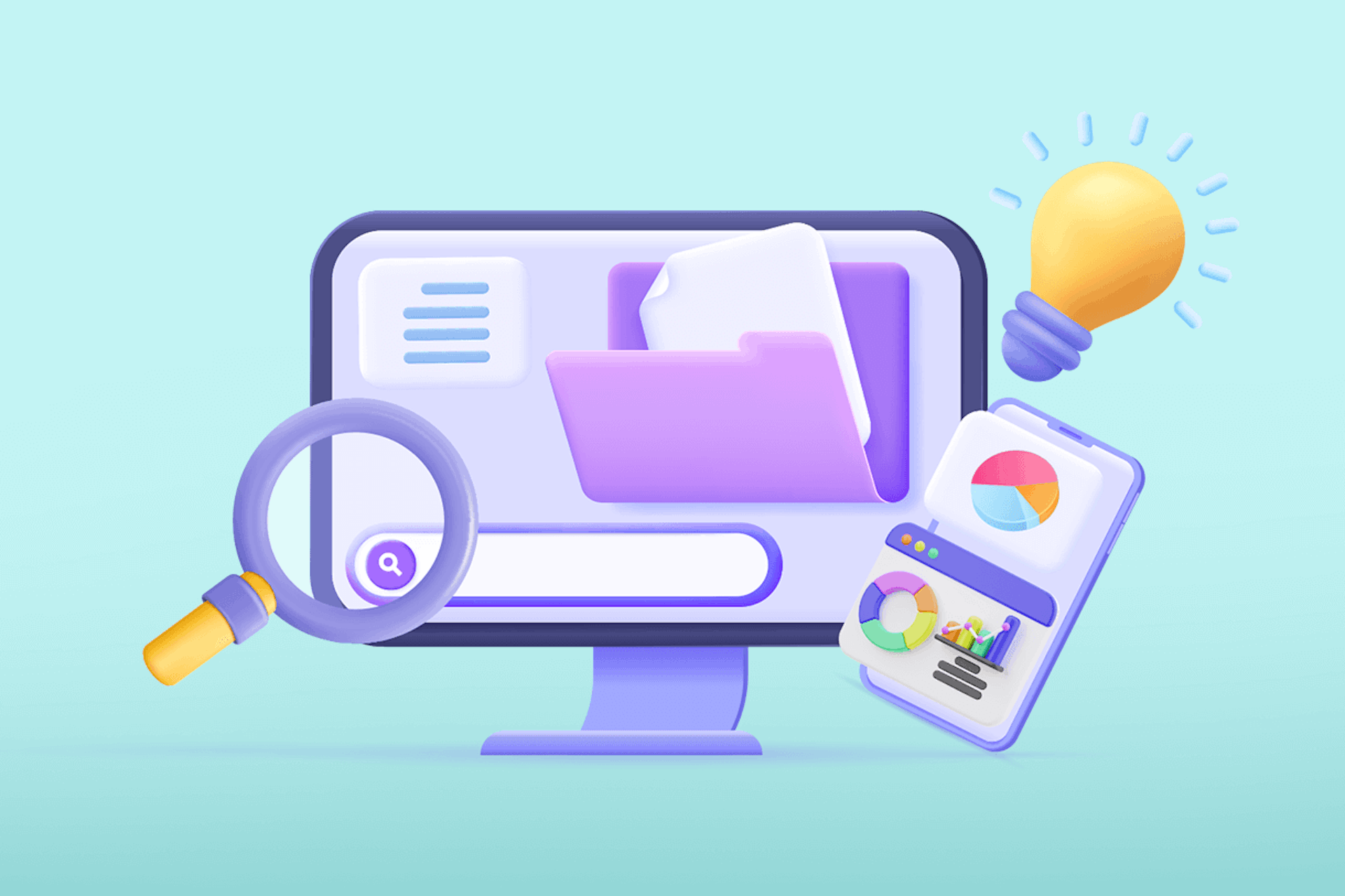
How To Do Market Research: Definition, Types, Methods

How to Gain a Sustainable Competitive Advantage with Porter's 3 Strategies
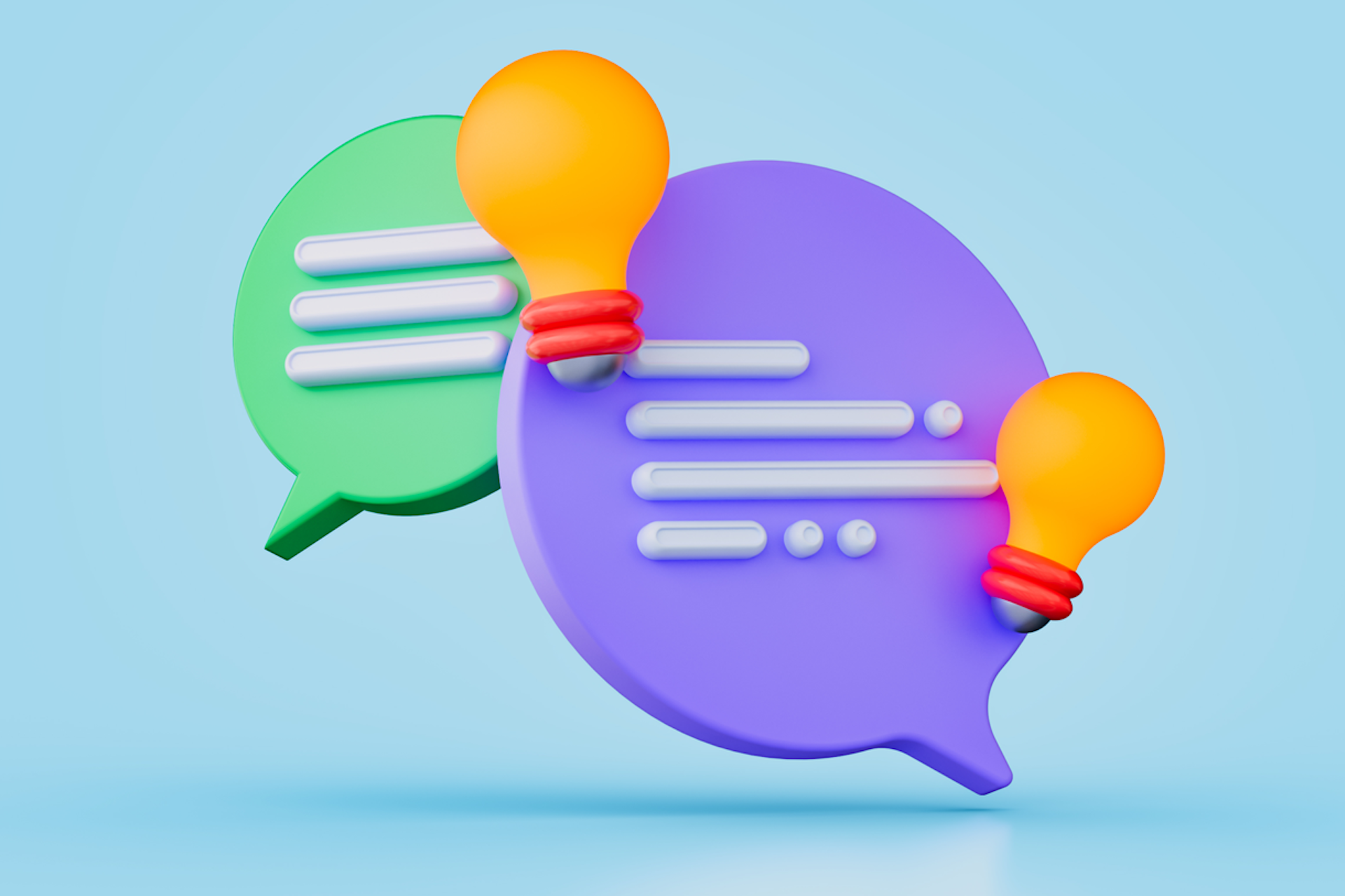
What Are Consumer Insights? Meaning, Examples, Strategy
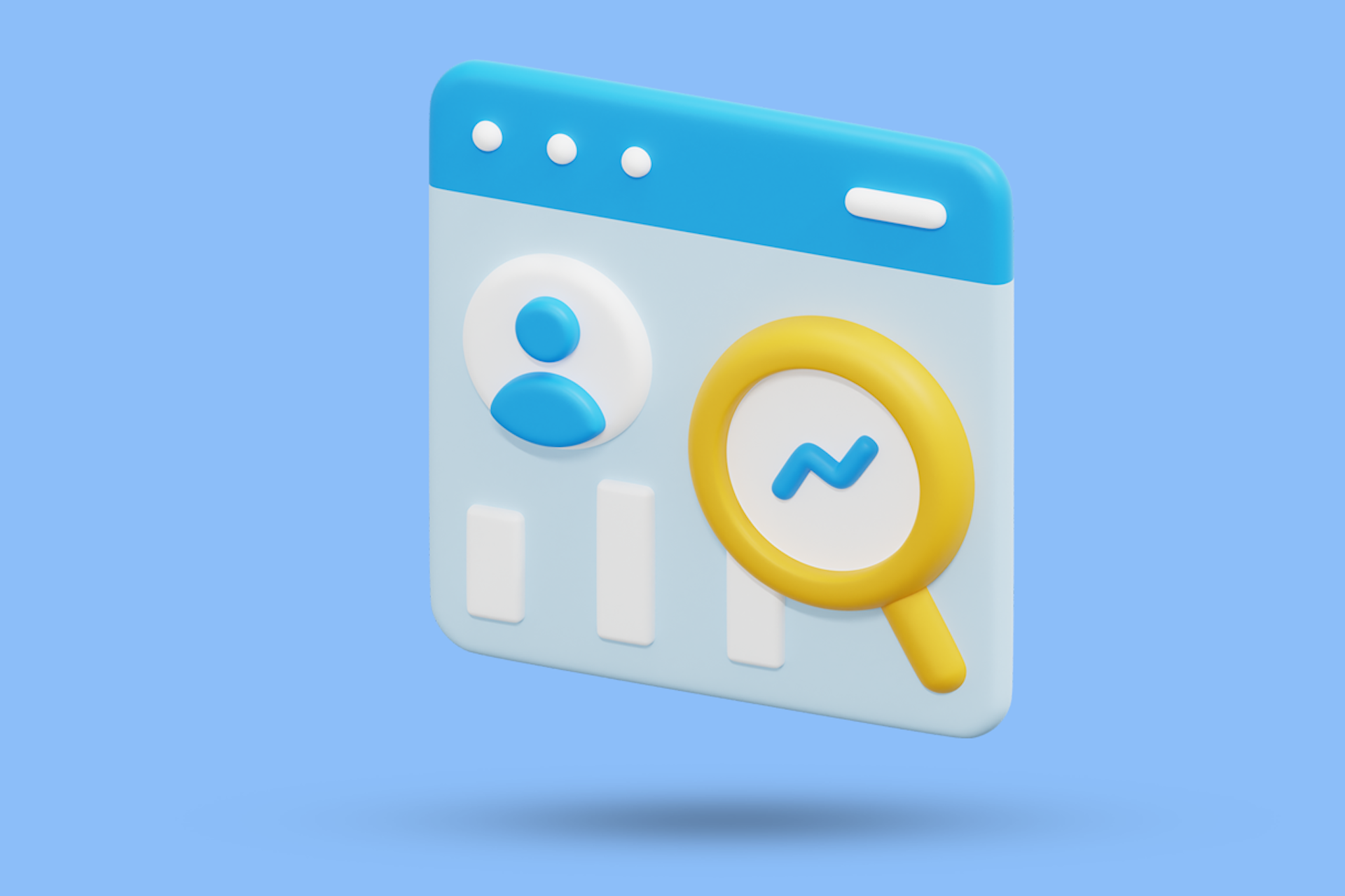
Consumer Intelligence: Definition & Examples
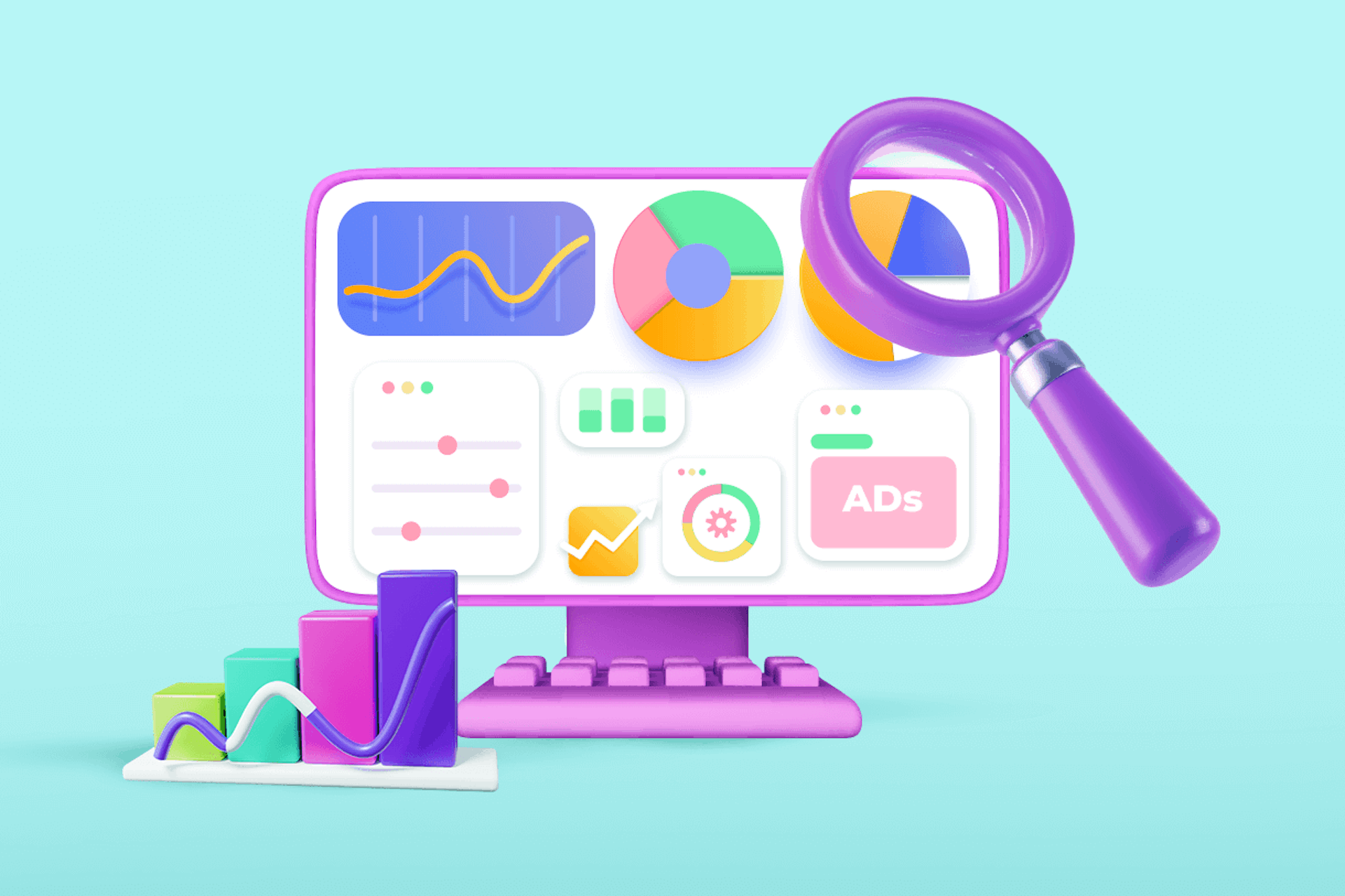
The 13 Best Market Research Tools in 2025
- Skip to main content
- Skip to primary sidebar
- Skip to footer
- QuestionPro

- Solutions Industries Gaming Automotive Sports and events Education Government Travel & Hospitality Financial Services Healthcare Cannabis Technology Use Case AskWhy Communities Audience Contactless surveys Mobile LivePolls Member Experience GDPR Positive People Science 360 Feedback Surveys
- Resources Blog eBooks Survey Templates Case Studies Training Help center
Home Market Research
Desk Research: What it is, Tips & Examples

What is desk research?
Desk research is a type of research that is based on the material published in reports and similar documents that are available in public libraries, websites, data obtained from surveys already carried out, etc. Some organizations also store data that can be used for research purposes.
It is a research method that involves the use of existing data. These are collected and summarized to increase the overall effectiveness of the investigation.
Secondary research is much more cost-effective than primary research , as it uses existing data, unlike primary research, in which data is collected first-hand by organizations, companies, or may employ a third party to obtain the data in your name.
LEARN ABOUT: Data Management Framework
Desk research examples
Being a cost-effective method, desk research is a popular choice for businesses and organizations as not everyone can pay large sums of money to conduct research and collect data. That is why it’s also called “ documentary research “.
Here are some more common secondary research methods and examples:
1. Data available on the Internet: One of the most popular ways to collect data for desk research is through the Internet. The information is available and can be downloaded with just one click.
This data is practically free or you may have to pay a negligible amount for it. Websites have a lot of information that companies or organizations can use to meet their research needs. However, you need to consider a reliable website to collect information.
2. Government and non-government agencies: Data for secondary research can also be collected from some government and non-government agencies. There will always be valuable and relevant data that companies or organizations can use.
3. Public libraries: Public libraries are another good source to search for data by doing desk research. They have copies of important research that has been done before. They are a store of documents from which relevant information can be extracted.
The services offered at these public libraries vary. Most often, they have a huge collection of government publications with market statistics, a large collection of business directories, and newsletters.
4. Educational Institutions: The importance of collecting data from educational institutions for secondary research is often overlooked. However, more research is done in colleges and universities than in any other business sector.
The data collected by universities is mainly used for primary research. However, companies or organizations can go to educational institutions and request data.
5. Sources of business information: Newspapers, magazines, radio and television stations are a great source of data for desk research. These sources have first-hand information on economic developments, the political agenda, the market, demographic segmentation and similar topics.
Companies or organizations can request to obtain the most relevant data for their study. Not only do they have the opportunity to identify your potential customers, but they can also learn the ways to promote their products or services through these sources, as they have a broader scope.
Differences between primary research and Desk Research
How to do a desk research.
These are the steps to follow to conduct a desk investigation:

- Identify the research topic: Before you begin, identify the topic you need to research. Once done, make a list of the attributes of the research and its purpose.
- Identify research sources: Subsequently, explain the sources of information that will provide you with the most relevant data applicable to your research.
- Collect existing data: Once the sources of information collection have been narrowed, check to see if previous data is available that is closely related to the topic. They can be obtained from various sources, such as newspapers, public libraries, government and non-government agencies, etc.
- Combine and compare: Once the data is collected, combine and compare it so that the information is not duplicated and put it together in an accessible format. Make sure to collect data from authentic sources so you don’t get in the way of your investigation.
- Analyze data: Analyze the data that is collected and identify if all the questions have been answered. If not, repeat the process to dig deeper into practical ideas.
- Most of the information is secondary research and readily available. There are many sources from which the data you need can be collected and used, as opposed to primary research, where data must be collected from scratch.
- It is a less expensive and time-consuming process, as the required data is readily available and does not cost much if it is extracted from authentic sources.
- The data that is collected through secondary or desktop research gives organizations or companies an idea about the effectiveness of primary research. Thus, a hypothesis can be formed and the cost of conducting the primary research can be evaluated.
- Doing desk research is faster due to the availability of data. It can be completed in a few weeks, depending on the objective of the companies or the scale of the data required.
Disadvantages
- Although the data is readily available, the credibility and authenticity of the available information must be assessed.
- Not all secondary data resources offer the latest reports and statistics. Even when they are accurate, they may not be up to date.
Desk research is a very popular research method, because it uses existing and reliable data that can be easily obtained. This is a great benefit for businesses and organizations as it increases the effectiveness of the investigation.
QuestionPro provides the best market research platform to uncover complex insights that can propel your business to the forefront of your industry.
START A FREE TRIAL
MORE LIKE THIS

QuestionPro Workforce Has All The Feels – Release of the New Sentiment Analysis
Dec 19, 2024

The Impact Of Synthetic Data On Modern Research

Companies are losing $ billions with gaps in market research – are you?
Dec 18, 2024

CultureAmp vs Qualtrics: The Best Employee Experience Platform
Dec 16, 2024
Other categories
- Academic Research
- Artificial Intelligence
- Assessments
- Brand Awareness
- Case Studies
- Communities
- Consumer Insights
- Customer effort score
- Customer Engagement
- Customer Experience
- Customer Loyalty
- Customer Research
- Customer Satisfaction
- Employee Benefits
- Employee Engagement
- Employee Retention
- Friday Five
- General Data Protection Regulation
- Insights Hub
- Life@QuestionPro
- Market Research
- Mobile diaries
- Mobile Surveys
- New Features
- Online Communities
- Question Types
- Questionnaire
- QuestionPro Products
- Release Notes
- Research Tools and Apps
- Revenue at Risk
- Survey Templates
- Training Tips
- Tuesday CX Thoughts (TCXT)
- Uncategorized
- What’s Coming Up
- Workforce Intelligence

Up to 65% off on all yearly plans! 🎁 Start fresh with a yearly plan. Now 65% off! ❄️ 🏷️
- Form Builder
- Survey Maker
- AI Form Generator
- AI Survey Tool
- AI Quiz Maker
- Store Builder
- WordPress Plugin
HubSpot CRM
Google Sheets
Google Analytics
Microsoft Excel
- Popular Forms
- Job Application Form Template
- Rental Application Form Template
- Hotel Accommodation Form Template
- Online Registration Form Template
- Employment Application Form Template
- Application Forms
- Booking Forms
- Consent Forms
- Contact Forms
- Donation Forms
- Customer Satisfaction Surveys
- Employee Satisfaction Surveys
- Evaluation Surveys
- Feedback Surveys
- Market Research Surveys
- Personality Quiz Template
- Geography Quiz Template
- Math Quiz Template
- Science Quiz Template
- Vocabulary Quiz Template
Try without registration Quick Start
Read engaging stories, how-to guides, learn about forms.app features.
Inspirational ready-to-use templates for getting started fast and powerful.
Spot-on guides on how to use forms.app and make the most out of it.
See the technical measures we take and learn how we keep your data safe and secure.
- Integrations
- Help Center
- Sign In Sign Up Free
- What is desk research: Definition, tips & examples
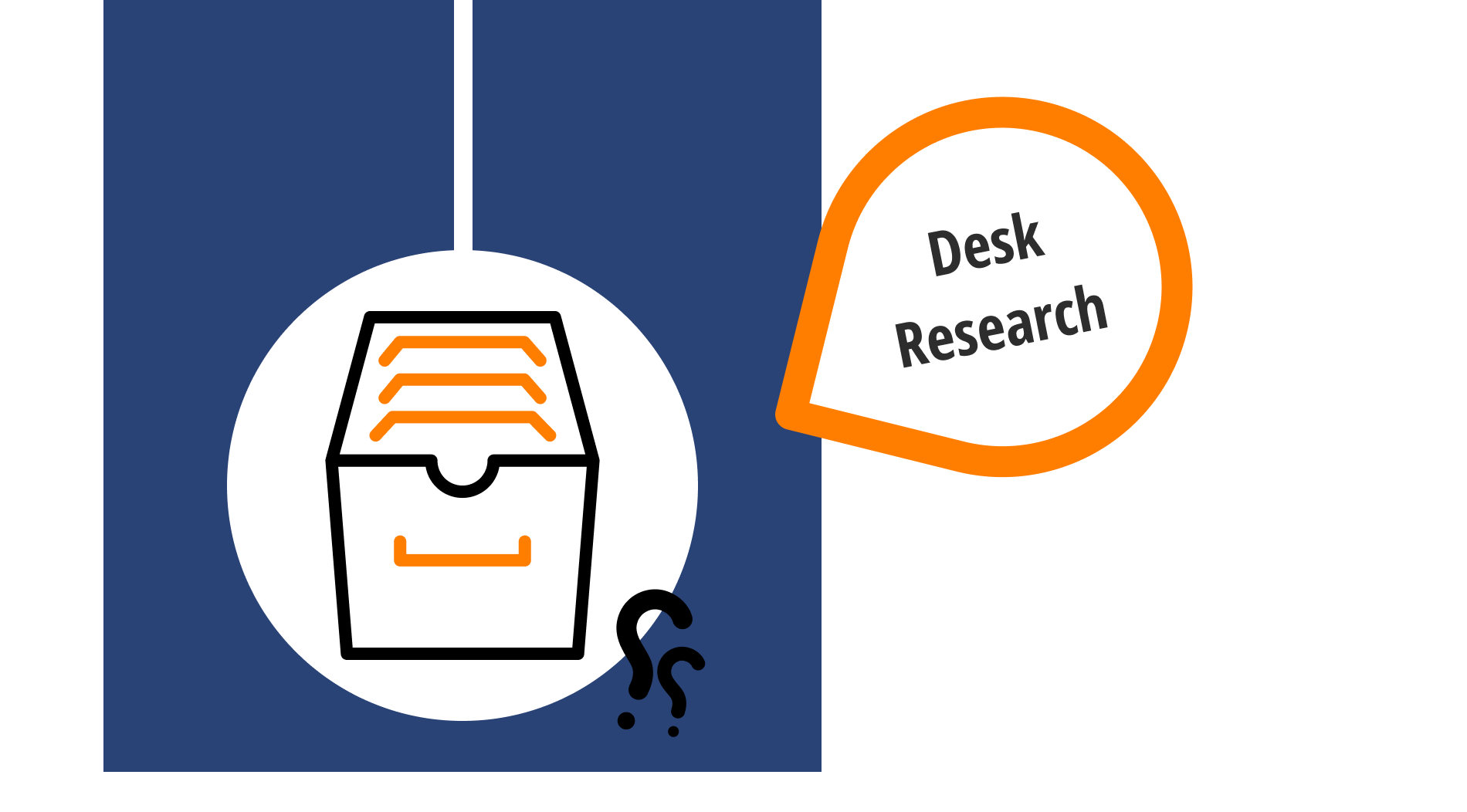
Defne Çobanoğlu
Every research starts with thinking and then continues with reading. Lots of reading 🤓. It’s because you have to know what other scientists, marketers, and researchers have found on the subject so you can build on it. This is basically what desk research is.
In this article, you will learn what secondary or desk research is and how to do it with some excellent tips and examples. Let us get started with the basic definition!
- What is desk research?
In layman’s terms, desk research is a type of research where you gather data while “ sitting at a desk .” It is another name for secondary research where the study itself is desk-based research and not experiment-based research.
Broadly speaking, there are two types of main research types. One of them is primary research , where the researcher tries to gather data firsthand (directly from the data source). The other one is secondary research , where the researcher is going through secondary data from published books, case studies, and other quantitative research. In other words, secondary research basically equals desk research.
- Why do you need desk research?
No matter the objective of the study, desk research should always be the first step. Because previously done experimental research and explanatory research give a good starting point. If you can take advantage of the existing information, it is always constructive to see what was previously said. But that is not the only reason to use this research method. So here are the advantages of desk research:
✅Insightfulness
It would be foolish of you to just jump into the middle of research without doing any research beforehand. A researcher who collects data before going along with their plan will gather substantial information and continue with their plan with this obtained insightfulness.
✅Time efficiency
Conducting a full-on study from start to finish is quite time-consuming. However, secondary data is right there waiting to be inspected. Thanks to that, the data collection is very quick.
✅Availability
As mentioned above, the secondary data collection sources are available on many platforms. They can be found in libraries, databases, online sources, booklets, and many more.
✅Cost-effectiveness
In addition to the other advantages, doing desk research is very cheap, too. So long as you can access a library or have an internet connection, you can gather the appropriate data without a cost.
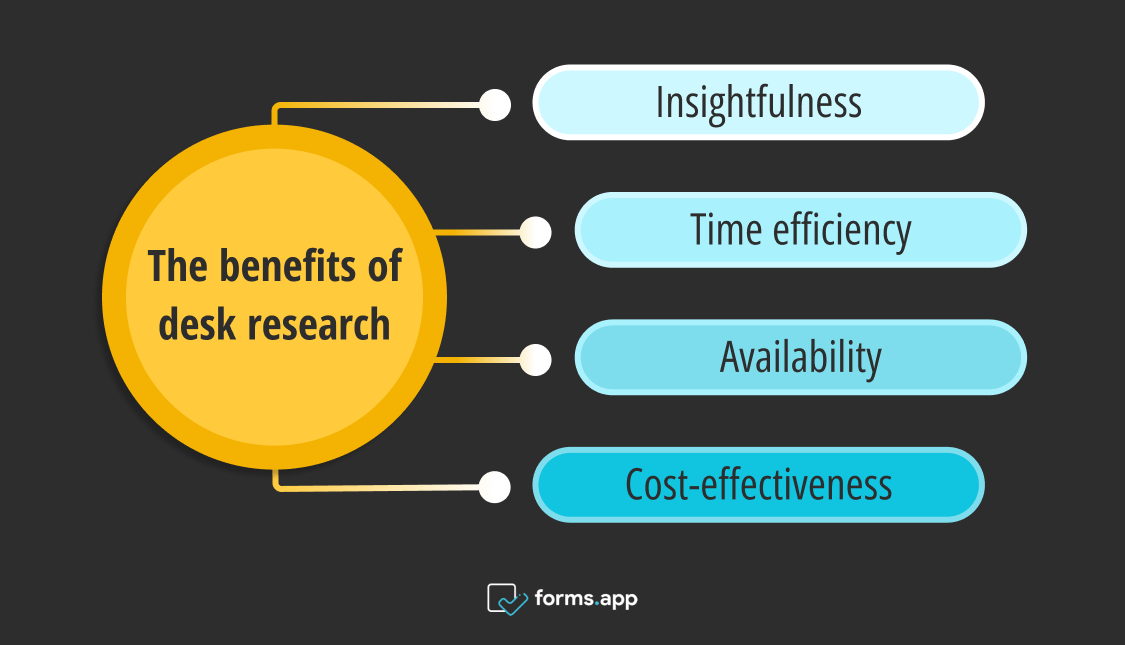
The benefits of desk research
- How to do desk research
The best approach to any research is a systematic one. That is why you should always have a plan or outline you will follow during your research. And we have gathered this step-by-step plan to guide you on your desk research. You can use it as is or build on these steps.
- Identify the topic: The first thing is to identify the research topic clearly to make sure you know what you want to know.. (You can change the topic as you explore the concept further.)
- Find research sources: Secondly, go on and identify the research sources.
- Collect data: Afterward, you can start collecting data from these sources. Go through every option to gather as much information as possible.
- Combine everything: Combine all that you gathered and compare it with the other information you collected. Make sure there are no contradictions.
- Make an informed analysis: The last step is to try to see if the findings answer the research topic well enough or not. If not, you can change the question or repeat the process. If you are satisfied with the findings you can decide if you want to continue with exploratory research methods to further your findings.
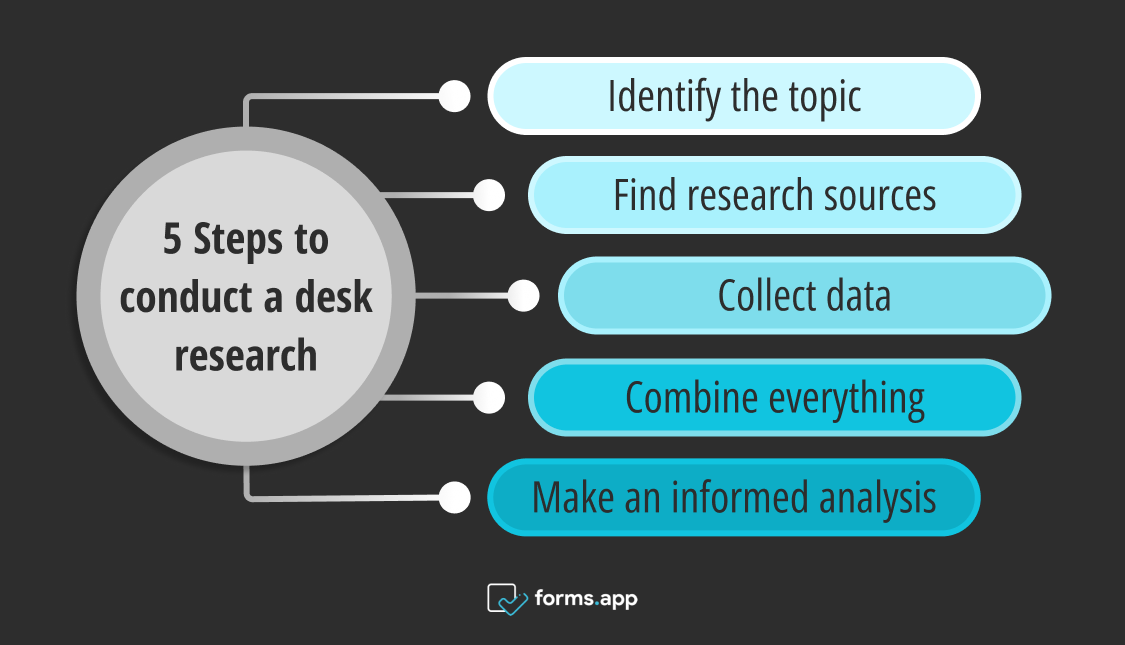
5 Steps to conduct a desk research
- Expert tips for desk research
Even the simplest task is best done by following a structured plan and organization. In addition to this, if you are planning to start your desk research, you should mind these smart tips to guide you in your way:
- Make sure the data you collect is not outdated .
- Take systematic notes while going through the sources so as not to get mixed up.
- Be critical and analytical and question your findings to make sure there are no contradictions.
- Do not limit yourself to just a few sources. It is better to make use of all options .
- Do not be biased. Stay open-minded . If you limit yourself to only a number of sources, your findings will be more than likely, insufficient. You should broaden your perspective by looking into various sides and frames.
- You can change course according to your findings. Do not feel limited to a frame.
- You can combine and support your findings with some primary research techniques such as surveys, interviews, or observations.
- Applications of desk research
Now, we know how to do desk research, what to have in mind, and its advantages. But on what occasions can you use this type of research? Let us see some examples of desk research.
1. Doing market research on a subject
When you want information on the latest fashion trends and clothing preferences of teenagers, it is best to consult appropriate data. You can read through magazines, fashion articles, fashion brand reports, and so on. Worth the data you obtain, you can build your fashion brand or create an eye-catching ad.
2. When you have an academic approach
Let us say you are a scholar who specializes in second language acquisition in children in a bilingual household. You can check out available online academic sources such as Google Scholar, ResearchGate, Wiley Online Library, or Library Genesis. There, you can find previously done studies, articles, and statistics.
3. Getting a general idea of a specific group of people
Let us say you will work with or around university students aged 18-28, and you want to know more about their behaviors and preferences to make informed decisions. You can use sources such as textbooks, news articles, reviews, journal entries, and previously done interviews and surveys.
- Frequently asked questions about desk research
What are the common resources for desk research?
The sources for desk research are limitless. Because they are basically every study conducted on the research topic. As long as they are organized, tangible, and objective , there is no problem using them. Some appropriate resources for desk research are:
- Published books
- Case studies
- Directories
- Company financial data
- Government statistics
- Commercial publications
When is desk research not reliable?
You may go through the relevant sources all you want, but if you fail to make sure the data is accurate, this can disrupt your project. There are some instances where desk research is not reliable and usable. For example, you can not use information that is outdated, biased, insufficient, irrelevant, or inaccurate .
Desk research vs. Empirical research
Empirical research is based on observation as directly experienced by the researcher. And even though secondary research backs up the theory part, empirical data is a primary research method . In desk research, the researcher goes through existing sources; therefore, desk research is a secondary research method.
Desk research vs. Primary research
Desk research is also known as secondary research and it involves collecting data from secondary sources such as published documents. And, primary research involves collecting data directly from the original sources. For example, doing experiments, observations, or interviews.
Desk research vs. Field research
Desk research, also known as secondary research, is when data collection is completed from secondary sources such as published documents or website sources. Field research, also known as primary research, is when data collection is directly from the source about a specific subject.
In desk research you collect pre-existing information while in field research you create new knowledge via exploration.
Desk research is an essential part of any study, no matter the concept. Thanks to desk research, the researcher collects all available data to draw their own conclusions or support their research theory.
It can be done using a number of source materials from books, reports, analyses, and entries. İt is a valuable part of the study. Desk research has its own advantages, and it can be perfected with some tips as well. What's more, you can use a smart tool such as a form and survey maker tool like forms.app to help you with all your research subjects!
Defne is a content writer at forms.app. She is also a translator specializing in literary translation. Defne loves reading, writing, and translating professionally and as a hobby. Her expertise lies in survey research, research methodologies, content writing, and translation.
- Form Features
- Data Collection
Table of Contents
Related posts.

How to use a Likert scale in a survey (examples & tips)
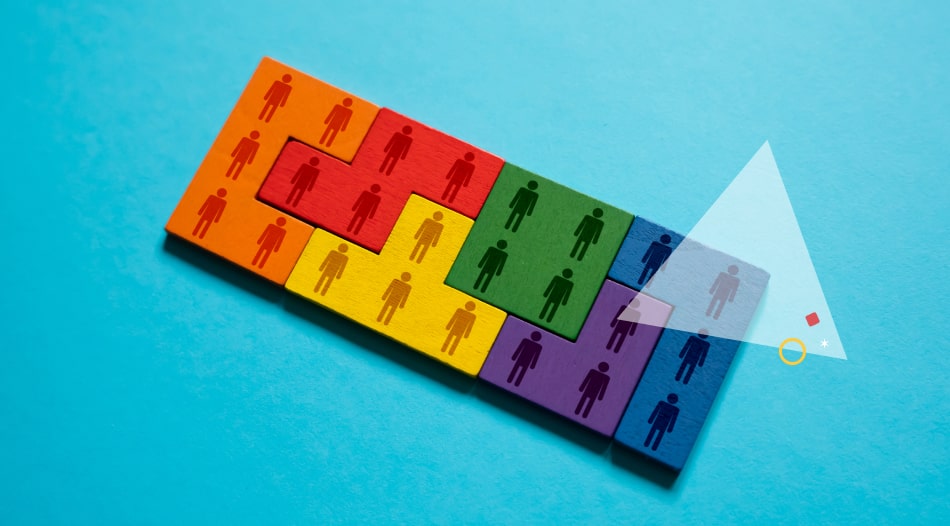
How to optimize lead generation forms (+9 examples)
forms.app Team

The best survey tools for 2024
What is Desk Research? A Guide + Examples

Free Website Traffic Checker
Discover your competitors' strengths and leverage them to achieve your own success
Desk research can help you make data-driven decisions, define or adapt strategies, and uncover untapped market potential to drive growth – when it’s done right!
Nowadays, we have all the information we need at our fingertips; but knowing where to find the right data quickly is key.
So, what is desk research? What does it involve, and how can Similarweb Research Intelligence help?
Let’s find out.

What is desk research?
Desk research is a type of market research that uses existing data to support or validate outcomes and conclusions. Also known as secondary research , it’s a cost-effective way to obtain relevant data from a broad range of channels.

How is desk research used?
From small start-ups to established businesses, doing desk research provides you with crucial insights into trends, competitors, and market size . Whatever you do, desk research can help with product positioning and guide data-driven business decisions that help you become the ultimate competitor and find new ways to grow.
According to the latest data on the Internet of Things , around 130 new devices connect to the web every second. Stats on the state of data show we create and consume data at an exponential rate–data interactions will only continue to rise.

Primary vs. secondary research – what’s the difference?
Most market research methods fall into either primary or secondary research. When we talk about desk research, we tend to focus only on secondary methods. However, most primary research can also be done remotely, from a desk.

Primary research is self-conducted research that gathers data to answer questions. It usually involves going directly to a source, such as a customer or a prospect. Compared to secondary research, it takes longer, costs more, and demands more resources. Primary research methods include interviews, market research surveys , questionnaires, competitor reviews, market mapping , focus groups, etc.
Secondary research is the synthesis or summary of existing research using previously gained information from various sources. Most market research starts with secondary research: It aims to provide a researcher or analyst with a basis of knowledge formed from existing data. Secondary research methods include collecting data from the internet, government databases, reports, and academic journals, to name just a few.
Pros and cons of desk research
As with any type of market research, you need to choose the right method to deliver the best outcome for your research goal. Desk research is advantageous for several reasons, but it won’t always suit every market research project. Market research best practice tells us that we should use desk-based research before primary research – as this helps to reduce or refine the scope of the work before the second, more costly phase.
Here’s a summary of the pros and cons of desk research.
Advantages of desk-based research
Doing secondary market research is highly beneficial; here’s why.
- Low cost – most secondary research sources are low-to-no cost.
- Speed – as the data already exists, data collection is quick.
- Clarity – desk research drives & add-value to primary research actions.
- Scalability – due to the large datasets used in secondary research.
- Availability – pre-collected data is readily available to analyze.
- Insightful – get valuable insights and help resolve some initial research questions.
Disadvantages of desk-based research
As any good researcher will attest, it’s always good to look at a topic from every angle. Here are a few things to consider before starting any secondary research process.
- Out of-date data – consider if the coverage dates of the research are relevant. In a fast-moving market, having access to up-to-date information could be critical.
- Lack of perceived control over the data – secondary research is undertaken by a third party; as such, methodology controls need to be reviewed with caution.
- No exclusivity – desk research data is widely available and can be used by other researchers.
- Verification & interpretation – particularly when working with large data sets, it can take time to analyze and review to ensure the information is suitable for your research.
Types of desk-based research
Nowadays, you can do most market research from a desk. Here, I’ll focus solely on secondary research methods: Where finding and using the right resources is key. The data you use needs to be up-to-date and should always come from a trusted source.
Desk research methods – internal data resources
Before stepping into external research, look for any relevant internal sources. This data can often prove invaluable, and it’s a great place to start gathering insights that only you can see. The information is already yours, so aside from the fact it won’t cost a dime, it’s data your rivals won’t have access to.

Sources of internal information that can help you do desk research include:
- Historical campaign and sales analysis: Everything from website traffic and conversions through to sales. Accessible through your own analytics platform(s).
- Website and mobile application data: Your own platforms can also tell you where users are – such as the device split between mobile and desktop.
- Existing customer information: audience demographics , product use, and efficiency of service.
- Previous research conducted by other analysts: Even if the research seems unrelated, there could be indicative information within.
Desk research methods – external data resources
Using external data sources for desk research is an ideal way to get information about market trends, and explore a new topic.

- The internet: A virtual aggregator of all secondary research sources – always validate findings with credible sources.
- Commercial resources: Research associations and company reports usually cost money but give you data that’s specific to your industry/aim.
- Trade association reports: To see if there’s a trade association of interest, do a quick search online or use the Directory of Associations , or the National Trade and Professional Associations Directory
- Industry Experts: Expert consultancy is an efficient way of getting information from someone who has ‘been there, done that.’ Also, consider ‘influencers.’
- Research associations & journals: Most research associations are independent and offer bespoke, specialized reports.
- Media coverage: TV, radio, newspapers, and magazines can often help uncover facts and relevant media stories related to your topic.
- Market research intelligence software: Platforms like Similarweb give you actionable insights into industry and competitors’ trends. With access to mobile app intelligence, you get a complete picture of the digital landscape.
- Government & non-government agencies: In the US, the biggest generator of data is the federal government. US Census Bureau , Congressional Research Service , US Government Publishing Office , US Small Business Administration , and the Department of Education . Most information from these sources is free.
- Local government sites: A reliable source to find data on population density or employment trends.
- Public library records: Access data via the Digital Public Library of America in the US or the National Archives in the UK.
- Competitor information: Sign-up for mailing lists, view comparison reports, and read online reviews.
- Educational institutions: Academic research papers and journals are well-researched. If you can find a relevant one, you’ll likely get solid data from credible sources.
How to choose the best type of desk research
With so many freely-available sources online for desk-based research; it’s easy to feel overwhelmed. The best guidance I can offer is to keep a list of key questions you are trying to answer with this research, and consider:
- What are you hoping to learn from your research?
- Why is this data relevant?
- Is there an action you can take from this information?
- How up-to-date is the data you are using?
Always keep the questions you’re trying to answer front of mind. It’ll help you stay focused and keep your desk research on the right track. Time and money will usually determine the right type of desk research to use, but, even then, it’s important to stay focussed on where you spend your time vs. the return on that investment.
Inspiration: This article outlines some of the best market research questions to ask.
How to do desk research in five steps
Follow these steps to guide you through doing desktop research:
1. Clearly define your research topic Identify your topic and its purpose, then list any relevant research attributes.
2. Select appropriate resources Make a list of sources that’ll provide relevant information for your research topic.
3. Look for existing data Once you’ve collated your research sources, look for internal and external data relevant to your research topic. Remember to only use data from authentic sources.
4. Collate, compare & assemble Next, you’ll need to collate all the data you’ve obtained, remove any duplication, and bring it together into a usable format.
5. Data analysis The final step of doing desk research is to analyze the data. At this point, you should be able to see if your research questions have been answered. If any questions remain unanswered, go back to step 2, and look for alternative resources that will help you get clearer insights.

Desk-based research tools
Online resources are by far your most valuable asset for doing secondary research. However, software like Similarweb Digital Intelligence , Google Analytics (GA), and Google Search Console (GSC) can save you time and give you a more visually-appealing view of relevant data.
My list of go-to tools for desk research includes:
- Google Analytics & Search Console – your own site’s performance and visitor stats.
- Similarweb Digital Research Intelligence – uncover market, industry & competitor trends across web, mobile, and apps.
- Tableau – data visualization for presenting your findings.
- Competitor data – on rival’s websites, newsletters, and social media accounts.
Read: The best market research tools of 2023
Note that GA and GSC are free to use but limited in terms of what you can see outside your own site. With Similarweb, you can access virtually limitless industry-wide data.
Stop Guessing, Start Analyzing
Get actionable insights for desk research here
How Similarweb helps with desk research
Here are just a few examples of how Similarweb Digital Research Intelligence can help you with secondary research.
- Benchmarking yourself against your industry – Benchmarking suite
- Understand how competitor websites and apps perform – Company research module
- Get a full picture of your industry – Market research & industry analysis tools
- Understand how apps are impacting your market – App Intelligence
- Analyze consumer behavior – Audience analysis tool
- Understand the complete customer journey – Consumer journey tracker
Using research intelligence tools will save you time and money while removing bias from the data – ultimately giving you clarity and a complete view of the digital world relevant to your research topic.
Success Story: See how Airbnb uses Similarweb to reveal growth opportunities in new markets .
Desk research examples with Similarweb
A good example of desk research in action is looking into an industry to uncover market leaders, trends, relevant search trends, and an overview of a complete industry. Using the market analysis module in Similarweb, you can find out exactly what’s happening in your market, and make data-driven decisions that’ll help you increase market share , and drive faster, more sustainable business growth.
For this particular desk research example, I chose the airline industry.
Let’s dive in.
Industry Overview
See a snapshot of industry traffic and engagement metrics . This data is typically based on Similarweb’s index of the top 100 websites in a chosen vertical. You can easily create a custom industry , allowing you to do competitive benchmarking against specific companies in your market.

Industry Leaders
Quickly see who is winning in an industry using the Market quadrant analysis graph and industry leaders table. Analyze top-performing websites in your vertical, and dive into their traffic and engagement performance to view bounce rates, visit duration, monthly visits, month-on-month changes, unique visitors, pages/visits, and traffic share .

Industry Trends
Analyze trends in near real-time so you can take action when it matters most–not a quarter later. Create a personalized view of your industry for in-depth analysis and make informed decisions that will help you grow your market share.

Marketing Channels
Access valuable traffic metrics and insights for each marketing channel. See data for direct, social, display ads, paid search, referrals, emails, and organic traffic channels and evaluate performance for each. Uncover opportunities to grow your own traffic share, evaluate engagement and quality of traffic, and identify trends over time.

Search Trends (within an industry)
Discover trending topics and emerging search terms in any industry. View what’s trending, search volume, % change, volume trend, and traffic leaders for both branded and non-branded search in your sector. Use these insights to get an understanding of market demand, search intent, and audience interests within a specific category, brand, or product.

Demographics
Gain crucial insights into the audiences visiting your website, your competitors’ websites, and your industry as a whole. See gender and age distribution across web, mobile, or combined traffic channels, and compare your demographics with that of your rivals.

The market analysis element of Similarweb will help you answer some of your most important research questions, such as:
- How a specific industry grew over time
- Who the top and emerging players are in your industry
- Which products or services are trending and/or what are consumers searching for
- What demographics are relevant to you, and your competitors
The app intelligence module completes the picture and gives you a broad view of the digital landscape across your market. You can quickly see how apps are impacting your industry, and look at download, engagement, installs, ranking, and more.

Here, I’m sticking with the airline industry to establish whether or not android or iOS is the best fit for a new app. Immediately, I can see there are between 1-1.5M monthly active users on iOS vs. an equivalent of around 350,000k on Android.
Like what you see? Take a tour of Similarweb for yourself.
Discover industry insights for desk research here
Wrapping up
Good desk research helps you quickly uncover key information that can shape and steer successful market research projects. When done right, you’ll be able to answer questions and discover crucial data about your industry, competitors, and key trends to consider while building a strategy for growth.
Asking the right research questions from the onset and keeping these at the forefront of your mind throughout will save time and help direct your market analysis in the right direction.
Is desk-based research free?
Depending on the method used, desktop research can be done for free. If you require industry or government agency reports, these often carry a charge but are more likely to be free from bias when compared to commercially produced reports that (sometimes) receive sponsorship.
Which businesses can utilize secondary desk research?
Desk-based research can uncover crucial insights into market trends, market sizing, and competitors. The information can be used by any size business to help guide strategic decision-making and help refine a product’s positioning.
Should you do secondary research before primary research?
Absolutely, yes. Secondary research should always come before primary or field research. The formative research phase helps pinpoint where more in-depth primary research is required. Desk research can also verify and support findings from field research but should not replace primary research–as they are each utilized under different circumstances.
Who does desk-based research?
Desk research can ‘technically’ be done by anyone, but it’s typically performed by a researcher, an analyst, or a marketing professional. Good market research has solid foundational data to drive critical business decisions. Experienced researchers and analysts are best-placed to spot opportunities, trends, and patterns when the stakes are this high.
So, while anybody can access secondary data free of charge, investing the necessary resources to do things right to get the most out of the process is essential.

by Liz March
Digital Research Specialist
Liz March has 15 years of experience in content creation. She enjoys the outdoors, F1, and reading, and is pursuing a BSc in Environmental Science.
Related Posts

20 Mobile App Metrics To Track In 2025

2025 Market Research Industry Statistics, Facts, and Trends

7 Common Types of Website Traffic Sources Explained

Traffic Attribution: Understanding Marketing Attribution Models

Qualitative Data Analysis Methods and Techniques

Market Saturation: Definition, Examples, and How to Avoid It
Track your digital metrics and grow market share.
Contact us to set up a call with a market research specialist
Marketing91
Desk Research: Definition, Importance and Advantages
December 21, 2024 | By Hitesh Bhasin | Filed Under: Marketing
Research is an integral part of the marketing of every business. The success of a business depends on the acceptability of the product. Research is used to understand the expectation of the target audience. The outcome of thorough research helps in developing a successful marketing plan.Research can be categorized into two broad categories, primary research and desk research or secondary research.
Read this article to learn the definition of desk research, what is desk research, the importance of desk research, reasons to conduct desk research, advantages of desk research, and steps to do desk research.
Table of Contents
Desk research can be defined as a type of market research where the information about the topic in research is available in printed form or published on the internet, in newspapers, magazines, and government reports is collected and analyzed.
What is desk research?

Desk research is a type of research that can be performed over a desk. In this type of research, a researcher finds, collects, and reviews the publicly available data about the research topic. In primary research, the researcher interacts with people and collects data firsthand using different primary research methods.
On the other hand, desk research is conducted by gathering and analyzing information available on public platforms such as internet forms, newspaper articles, magazines, market intelligence, government reports, databases, statistics, and data sets.
The desk research is also popularly known as secondary research, as in this research, the data for the analysis is not collected by involving participants. But the previously existed data is gathered and studied. The researcher conducts research sitting behind his or her desk by collecting the previously existing data.
Many organizations prefer desk research because it helps to establish an understanding of the research topic at a very low-cost. In addition to this, the information collected from the desk research is verified by the public. Hence, the outcome of the research is reliable.
Moreover, desk research can be categorized into two categories: internal desk research and external desk research. Internal desk research is referred to as the analysis of internal reports, data sets, and organization statistics. At the same time, external desk research is applied to the study of information collected from the external sources.
Market research is an essential part of every business. A business needs to understand the product’s demand that they want to launch in the market. Research is the only method to learn about the market condition and the acceptability of the product.
Companies adopt two research methods to analyze the market condition, such as primary research and secondary research. However, conducting primary research is quite expensive and requires a lot of effort and resources.
Therefore, organizations opt for secondary research methods to learn about the field of research. Conducting desk research is a cost-effective method to establish an understanding of the area.
Advantages of desk research

Desk research is one of the essential market research that many organizations opt to learn about their investment. The following are the advantages of conducting desk research.
1. Inexpensive
The first benefit of conducting desk research is that it costs almost nothing. You need to have a desktop and internet connection to perform this type of research.
If you are new in the business world and want to start your business from scratch, then it is understood that you are low on budget to conduct primary research.
Therefore, secondary research is the best option for you to understand the market segment you want to enter and the demand for the product in the market.
2. Helpful in making well-informed decisions
Marketing plays an essential role in the success of every business. A company spends a considerable amount of money to market their product. A manager can make better decisions when they understand the field better.
The desk research allows managers to understand the demands and needs of consumers. Thus, they can create effective marketing plans for their products and services.
3. Helpful in finding new opportunities
Through desk research, a manager can learn about the business opportunities available in the market.
They can analyze the competition in the market and can position their product in such a way so that they can increase their market share.
4. It takes less time to conduct
Secondary research can be undertaken in comparatively less time than the primary research. With the help of technology and using public sources, the information can be collected in very little time.
5. Helpful in focusing the research
Many times, managers face the problem of having one focused research topic. In such a scenario, conducting primary research will be a waste of time and a waste of resources.
The companies can either hire experts in conducting secondary research or use the services of third-party organizations that help you in conducting the secondary research.
Disadvantages of desk research
1. Unreliability of data
Relying on the data collected through desk research is a little risky. The data that you are basing your research on can be outdated as government organizations don’t update their data regularly. Their statistics and database are updated once or twice a year.
2. Difficult to find specific data
Another disadvantage of desk research is that you can’t find accurate data for your research topic. Secondary research is useful to establish an understanding of the research topic, but reaching conclusions only based on the desk research outcome is not advisable.
3. No control over the participants and the methods of research
In secondary research, the data you collect or analyze is based on the research conducted by others. Therefore, as a researcher, you cannot control the research participants and the methods used by them.
Here is a video by Marketing91 on Desk Research.
Resources of desk research

The following are the sources that can be used to collect data for desk research.
1. Business libraries and databases
All large libraries have business sections where one can access the latest material in different fields of business. Many libraries also provide access to online business sources. Therefore, if you are an entrepreneur and want to do preliminary research for your business, libraries are the best source for you to conduct your desk research.
2. Local directories
Local directories are the best place to conduct desk research if you want to start a business locally and have information about your competitors.
Local directories can provide you information about your local competitors and the product and services.
3. Trade associations
The members of an industry form trade associations.
If you want to enter an industry, it will help you have connections in their trade association. Business associations provide statistics, reports, and data to their members.
4. Market research report
Market research reports contain information about a particular market segment. These reports contain information such as threats and opportunities in a specific market. Several organizations sell market research reports.
You can buy research reports to conduct desk research.
5. Newspapers and magazines
Newspapers and magazines are one of the cheapest and readily available sources. In all newspapers, there is a business section where they print business news and market.
Similarly, business magazines publish news about different industries. You can buy their latest copies and can access older copies from your local library.
Steps to conduct desk research
Carrying desk research requires skills and knowledge to scrutinize the right sources to collect data. Whether you want to write a personal story or research a business opportunity, desk research will help you do it effectively.
In this section, you will learn about the steps you can follow to conduct effective desk research.
Step 1: Define the objective of your research
Conducting desk research will become a lot easier if you have a predefined objective for your research. If you are not sure about your research’s objective, you should list down all the questions you want to research.
Your research should be focused on finding the answers to all of these questions. Follow the logic of going from general research to reaching a precise research topic. Lastly, have a rough idea of how much information you want to collect so you will know when to move to the next step.
Step 2: Make a research plan
Now, this step might contradict your pre-notion about the desk research. Most people believe that desk research takes place without following a plan. But, trust me, having a research plan will make your research work a lot easy.
Choose a research method that you will use and the tool that you will use to collect and analyze your research data.
Step 3: Select a deadline
Having a deadline to conclude your research will make your research work fast and will save you from wasting your time procrastinating, and you will end up conducting your research in less time.
Step 4: Conduct research
Conducting desk research means collecting the data from reliable sources and analyzing them to reach conclusions. Ensure the reliability of the data source and analyze the information collected using tables and flow charts.
Step 5: Reach conclusions
Once you have collected enough information and have organized and analyzed it properly, then reaching conclusions will not be difficult for you.
Your whole effort to conduct research will be successful only if you understand the information entirely and draw conclusions from it without any confusion.
Desk research or secondary research is conducted by collecting and analyzing the data collected by other researchers. Using desk research, you can establish an understanding of your research field by spending fewer resources like time and money.
Did you know the impact desk research can have on your business decisions?
According to a study published in the Harvard Business Review, companies that rely on data-driven decision-making are 5% more productive and 6% more profitable than their competitors (Source: Harvard Business Review, 2017). This underscores the importance of thorough desk research in forming effective business strategies.
A survey by PwC found that data-driven organizations are three times more likely to report significant improvements in decision-making (Source: PwC’s Global Data and Analytics Survey, 2016). This highlights how investing time in desk research can lead to significant advantages in the competitive market.
Liked this post? Check out the complete series on Market research
Related posts:
- Research Ethics – Importance and Principles of Ethics in Research
- Sales Account – Definition, Importance, Advantages
- Crowdsourcing – Definition, Importance And Advantages
- Promotional Pricing: Definition, Types, Importance and Advantages
- Brand Leadership – Definition, Importance, Advantages and Examples
- What is Research Design? Type of Research Designs
- How to Write Research Proposal? Research Proposal Format
- 7 Key Differences between Research Method and Research Methodology
- Qualitative Research: Meaning, and Features of Qualitative Research
- Primary Research – Meaning, Process and Advantages
About Hitesh Bhasin
Hitesh Bhasin is the Founder of Marketing91 and has over a decade of experience in the marketing field. He is an accomplished author of thousands of insightful articles, including in-depth analyses of brands and companies. Holding an MBA in Marketing, Hitesh manages several offline ventures, where he applies all the concepts of Marketing that he writes about.
All Knowledge Banks (Hub Pages)
- Marketing Hub
- Management Hub
- Marketing Strategy
- Advertising Hub
- Branding Hub
- Market Research
- Small Business Marketing
- Sales and Selling
- Marketing Careers
- Internet Marketing
- Business Model of Brands
- Marketing Mix of Brands
- Brand Competitors
- Strategy of Brands
- SWOT of Brands
- Customer Management
- Top 10 Lists
Leave a Reply Cancel reply
Your email address will not be published. Required fields are marked *
- About Marketing91
- Marketing91 Team
- Privacy Policy
- Cookie Policy
- Terms of Use
- Editorial Policy
- Advertise with us
WE WRITE ON:
- Digital Marketing
- Human Resources
- Operations Management
- Marketing News
- Marketing mix's
- Competitors
- Customer Relationship Management
Desk Research - Methodology and Techniques
As depicted by name Desk Research is the research technique which is mainly acquired by sitting at a desk .
Desk research is basically involved in collecting data from existing resources hence it is often considered a low cost technique as compared to field research, as the main cost is involved in executive’s time, telephone charges and directories. However, it could also be a complete waste of time and money if the researcher does not have the proper knowledge of how the research is performed.

Desk research is very effective and can be conducted in starting phase of market research as it is quite quick and cheap and most of the basic information could be easily fetched which can be used as benchmark in the research process.
There are basically two types of desk research techniques:
The main advantage here in performing internal desk research is that it involves internal and existing organizational resources to organize the collected data in such a way that it is not only efficient but also usable. Internal desk research is comparatively very cheap and effective as internal recourses are deputed and the expenditure in getting data from outside is less.
There could be two approaches for digging out the relevant information from internet, one is directly browsing the specific information from industrial, marketing or business sites and extracting the information out of these sites. Secondly, using the various search engines like www.google.com, www.yahoo.com, www.infoseek.go.com, www.altavista.com etc, for modulated searching.
The important aspect here is to refine the searching techniques in such a way that results are promising and relevant. For this it is necessary that the researcher should know the importance of the research and follow the guideline intellectually to reduce the efforts made and time consumed in searching.
Customers are the one who are considered the most informed as they are actually using products and services and are aware of the current market trends more than any other. Hence the feedback and information provided by customers is the most accurate and useful data which can be used most effectively in the further process of research.
Related Articles
- Customer Relationship Measurement
- Market Research and CRM
- Market Research Process
- Field Research
- Data Analysis and Compilation
View All Articles
Authorship/Referencing - About the Author(s)
The article is Written and Reviewed by Management Study Guide Content Team . MSG Content Team comprises experienced Faculty Member, Professionals and Subject Matter Experts. We are a ISO 2001:2015 Certified Education Provider . To Know more, click on About Us . The use of this material is free for learning and education purpose. Please reference authorship of content used, including link(s) to ManagementStudyGuide.com and the content page url.
- Origin of CRM
- Features of CRM
- Importance of CRM
- CRM and Marketing
- Misunderstandings about CRM
- Benefits and Challenges of CRM Software
- CRM (Customer Relationship Management) Software and Its Importance
- What is Customer Relationship
- Types of Customers
- Orientation of Customers
- Customer Modeling
- Customer Profiling
- Regression Scoring
- Quality of Relatiosnhip with Customers
- Need of Relatiosnhip with Customers
- Customer Relationship with Supplier
- Cost Sensitivity of Customers
- Bargaining Power of Customers
- Desk Research
- Report Preparation
- Action Plan in Report Preparation
- Strategic CRM
- Operational CRM
- Analytical CRM
- Collaborative CRM
- Customer’s Response - Introduction
- Measuring Customer Response
- Medium of Customer Responses
- Qualities of a Good Response
- Response in Consumer Sector
- Customer Acquisition - Introduction
- Customer Life Cycle
- Customer Acquisition Cost
- Measuring Acquisition Equity
- Customer Loyalty - Introduction
- Customer Loyalty & Satisfaction
- Drivers of Customer Loyalty
- Customer Loyalty Breakers
- Tracking Customer Loyalty
- Increasing Customer Loyalty
- Building Customer Loyalty Through Modern CRM Strategies
- Customer Satisfaction
- Why Dissatisfaction in Customers
- Methods of Measuring Satisfaction
- Factors affecting Customer Satisfaction
- Customer Retention - Introduction
- Customer Retention Strategy
- Determinants of Customer Retention
- Methods/Tools for Customer Retention
- Myths about Customer Retention
- Benefits of Cloud CRM for Small Businesses
- UX consultancy
- UX training

Desk research: the what, why and how
The “where” (at your desk) and the “when” (at the beginning of your project) are easy questions to answer. But what is it, why do you need to to do it, and how should you go about doing desk research to make sure it adds value to your project? — David Travis , Jan 4, 2016
By David Travis Jan 4, 2016 / strategy
Comment, share or save this article
(opens a new browser window)

What is desk research?
Desk research is another name for secondary research. Broadly speaking, there are two types of research activity: primary research (where you go out and discover stuff yourself); and secondary research (where you review what other people have done). Desk research is not about collecting data. Instead, your role as a user researcher carrying out desk research is to review previous research findings to gain a broad understanding of the field.
Why do desk research?
Before carrying out a field visit, developing a prototype, running a usability test, or embarking on any project that you want to be user centred, it makes sense to see what people have done in the past that relates to the product’s domain. Although it’s unlikely that anyone has carried out the exact research activity you’re planning, someone has almost certainly tried to answer related questions. Reviewing this research is the quickest and cheapest way to understand the domain.
Carrying out desk research is a critical first step, for at least three reasons:
- If you don’t know what has gone before, you won’t know when you’ve discovered something new.
- You’ll sound credible when you get face-to-face with users and stakeholders. If you’ve not done this “due diligence”, you’ll ask dumb or irrelevant questions and may find your participants cut your sessions short.
- Failing to do preparatory research is disrespectful of your participants’ time. You may get less than an hour with a user of your system. Do you really want to waste half that time understanding the domain issues that you could have covered elsewhere?
How do you approach desk research?
At this point, I’ve had many user researchers tell me that they’re working on a bleeding edge design project so there isn’t any desk research to do. There’s a common misconception that no research exists.
In my experience, there is almost always something you can build upon. Here’s an approach I take to go about finding it. It helps me stay focussed but also makes sure that I remember to check all the possible nooks and crannies where relevant research findings may be hiding.
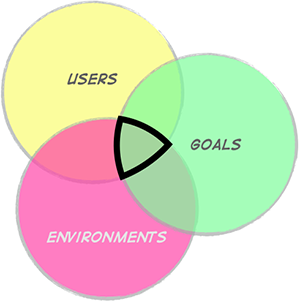
A Venn diagram showing users, goals and environments. Where these three overlap is the sweet spot for user research.
The Venn diagram describes the context of use: your users, their goals and the environments where the action occurs. The best kind of research is where all three of these dimensions overlap: field visits that focus on your users trying to achieve their goals in context. This kind of research is so specific and relevant to your project that it may be hard to find, so don’t get discouraged if you can’t turn anything up in this area.
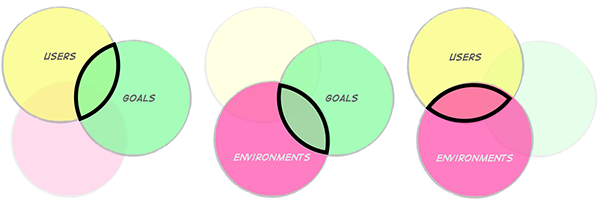
This set of Venn diagrams shows that research into the overlap between users and goals, environments and goals and users and envrionments can also yield useful insights.
But there is potentially useful research in the other areas of overlap on our Venn diagram. This falls into three broad areas:
- Research about your users and their goals, but that was not carried out in context. This kind of research will take the form of surveys, customer interviews and focus groups.
- Research that addresses the goals your system will support and the environment it will be used in, but doesn’t tell us much about users. Examples include call centre or web analytics.
- Research that uncovers information about your users in their environment, but that may not address the goals that your system will support. This will take the form of field research by teams who are designing a product for the same kinds of user but to meet different needs.
The most likely place you’ll find this kind of research is within your own organisation. But you need to be prepared to dig. This is because research findings, especially on agile projects, are often treated as throw-away by-products that apply to a specific project. The findings aren’t shared outside the design team but typically make a fleeting appearance on a research wall or end up buried in someone’s email inbox. Even when research findings are written down, and even when the report is archived somewhere, people typically don’t know how to go about finding it. Organisations are generally poor at creating a shared repository of knowledge and rarely teach staff how to use the intranet or where past reports might be located. The result of these obstacles is that companies waste time and money either doing research that already exists or asking the wrong research questions.
So within your organisation, you should:
- Talk to your stakeholders. Get to know the product owner and understand their goals, vision and concerns.
- Examine call centre analytics or web analytics (if there is an existing service).
- Talk to front line, customer facing people who currently interact with users.
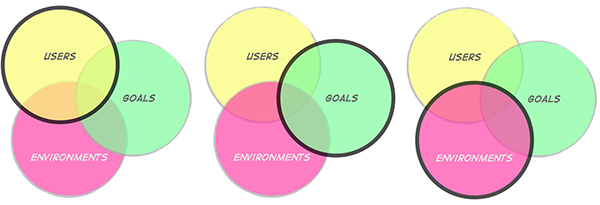
In almost every project, you'll find some research that exists into users, goals and environments. This may not be directly relevant to your specific research questions but it will help you become knowledgeable about the domain.
Once you’ve covered the areas of overlap, your next step is to look for more generic information about your users, the environment in which they’ll use the system, and the kinds of goals your system will support.
- What research has been done with your users, even if it’s not directly relevant to their goals when using your system?
- What research has been done on the kind of goals your system will support, even if the research has been done with a different user group?
- What research exists on the kinds of environment where you expect your system to be used (environment means hardware, software and the physical and social environments in which your system will be used).
In this step, you’ll find it useful to:
- Review existing research done by Government organisations.'In the UK, the Office for National Statistics has a wealth of information about citizens that may be useful to understand your users, such as demographics about Internet users , consumer trends and facts about online retail sales in the UK
- Review research carried out by relevant charities. For example, if you’re developing a new kind of tool to help diabetics measure their sugar levels, you should bookmark the research done by Diabetes UK . Web sites like Charity Choice allow you to browse through and locate hundreds of different charitable organisations so you’re bound to find at least one that’s relevant.
- Search Google Scholar to find relevant research carried out by universities. Although you may struggle to appreciate the nuances of certain academic arguments, you could always use this route to find the researcher’s contact details and give them a call.
- If your system will be used in a work context, study interviews at careers web sites. For example, The Guardian's careers section has interviews with people working as tattoo artists , forensic scientists , and as a royal footman so the chances are that you'll be able to get some context for whatever job title your system is aimed at. You should also check the Guardian's " What I'm Really Thinking " series.
Judging the quality of the research you find
Judging the quality of research is a whole article in itself. Fortunately, Philip Hodgson’s guidelines for reviewing consumer research reports has it covered.
There’s just one thing I’d add to Philip’s guidelines. Beware of dismissing research just because it was done a few years ago. People new to research often make the mistake of viewing research reports like so many yogurts in a fridge where the sell-by dates have expired. Just because it was done a couple of years ago, don’t think it’s no longer relevant. The best research tends to focus on human behaviour, and that tends to change very slowly.
Interested in this topic?
Find out more on our 3-day, user experience immersion seminar .
About the author

Dr. David Travis ( @userfocus ) has been carrying out ethnographic field research and running product usability tests since 1989. He has published three books on user experience including Think Like a UX Researcher . If you like his articles, you might enjoy his free online user experience course .
If you liked this, try…
- Guidelines for reviewing consumer research reports
- Is Consumer Research Losing Its Focus?
- What user researchers can learn from Sherlock Holmes
- You have 19 days to define your research problem
- Usability Test Data
Foundation Certificate in UX
Gain hands-on practice in all the key areas of UX while you prepare for the BCS Foundation Certificate in User Experience. More details
Download the best of Userfocus. For free.
100s of pages of practical advice on user experience, in handy portable form. 'Bright Ideas' eBooks .
Related articles & resources
This article is tagged strategy .
User Experience Articles & Videos
Our most recent videos
- Jul 3: User research when social distancing
- Jun 19: How to create bulletproof survey questions
- Jun 12: Can you re-use usability test participants?
- Jun 5: Why you don't need user representatives
- May 29: Should a design agency test its own design?
Our most recent articles
- Dec 2: Usability task scenarios: The beating heart of a usability test
- Nov 4: Common traps in user needs research and how to avoid them
- Oct 7: Transitioning from academic research to UX research
- Sep 2: The minimalist field researcher: What's in my bag?
- Aug 5: The future of UX research is automated, and that's a problem
See all videos
Filter articles by keyword
- accessibility •
- axure •
- benefits •
- careers •
- case study •
- css •
- discount usability •
- ecommerce •
- ethnography •
- expert review •
- fitts law •
- focus groups •
- forms •
- guidelines •
- heuristic evaluation •
- ia •
- iso 9241 •
- iterative design •
- layout •
- legal •
- metrics •
- mobile •
- moderating •
- morae •
- navigation •
- personas •
- prototyping •
- questionnaires •
- quotations •
- roi •
- selling usability •
- standards •
- strategy •
- style guide •
- survey design •
- task scenarios •
- templates •
- tools •
- usability testing •
- user manual
Our services
Let us help you create great customer experiences.
- User experience research
- User experience design
- User experience training
Upcoming courses
We run regular training courses in usability and UX.
UX Certification
- Online User Experience training
- Arrange in-house training
Training courses
Join our community of UX professionals who get their user experience training from Userfocus. See our curriculum .
- Privacy policy
copyright © Userfocus 2021. The Usability Training Centre is a trading name of Userfocus limited.

Get help with…
Get hands-on practice in all the key areas of UX and prepare for the BCS Foundation Certificate.
In-House Usability Training Courses
We can tailor our user research and design courses to address the specific issues facing your development team.
User Experience Consultancy
Users don't always know what they want and their opinions can be unreliable — so we help you get behind your users' behaviour.
Desk research
What is it and how do you conduct it properly, deskresearch.
- Research method
View our services

Language check
Have your thesis or report reviewed for language, structure, coherence, and layout.

Plagiarism check
Check if your document contains plagiarism.

APA-generator
Create your reference list in APA style effortlessly. Completely free of charge.
What is desk research?
Desk research vs. literature reviews, desk research as a research method, how do you properly tackle desk research, where do you find information for desk research.
Desk research means that you use previously collected data for your research instead of collecting it yourself. You answer your research question based on the existing data you analyze. This might include previous literature, company information, or other available data. What exactly is desk research and how do you conduct it properly?
When you do desk research, you collect existing data and use it to learn more about your research topic. You are not collecting quantitative or qualitative data yourself through things like surveys, interviews or observations.
In desk research, you work with secondary data (data collected by someone else). In field research, on the other hand, you work with primary data (data you collected yourself).
Desk research is an especially relevant research method if a lot of information on a topic is already available and/or if it is difficult to collect this data yourself. This type of research is less appropriate if you are one of the first to research the topic.
Often the terms "desk research" and "literature review" are used interchangeably. However, they don't mean exactly the same thing.
A literature review (also called "narrative review") is designed to gain more theoretical knowledge about a topic.
In desk research you collect existing research results or factual results in order to use them to explain a certain phenomenon. In doing so, you often answer an explanatory research question. You investigate a possible connection between variables.
You can use desk research as a research method on its own in your thesis. Your entire thesis research will then consist of desk research. In that case, you describe the results of the desk research in the results chapter. In the method chapter you explain how you approached the research.
It is also possible for you to use desk research as a stepping stone to a study that you will conduct yourself with data you have collected yourself. You arrive at hypotheses or theories through desk research that you then test through your own data collection. When you use desk research in this way, you incorporate its results into the theoretical framework. This type of research is called deduction .
You can also use desk research to supplement, for example, surveys, interviews , an experiment, or observations. In these cases, desk research can help explain the results you found.
If you are going to conduct desk research, you need to go through a number of stages to do so. For example, it is important that you select the right sources and report on the sources in a logical way. To do this, take the following steps:
Determine appropriate search terms. First, determine what search terms you will use to find sources through, for example, your educational institution's online library or Google Scholar. Often, you will use terms that appear in your problem statement or research question. Search for English search terms and any other languages you may want to include.
Find appropriate sources. You do this with the chosen search terms, but also, for example, by looking in the list of found sources. Perhaps there is another useful source cited by one of the articles you read through. Save all sources in one convenient folder and put them in your bibliography so you don’t forget them.
Determine which sources are relevant. Not all sources found are equally relevant to your topic. You also want to avoid having so many sources that you cannot see the forest for the trees. Check whether the sources you have found actually match your problem, research question, and research goal. Also check the reliability of the source. Ideally you should mostly use sources from leading journals and from authors who are affiliated with a scientific institute.
Incorporate the sources you found into your text. Are you doing a quantitative analysis? If so, you will first use SPSS or Excel. Are you referring verbatim to content from the sources? Then it's mainly a matter of putting relevant content together correctly in your thesis. Make sure you create a logical thread, for example by discussing sources by topic or in chronological order.
Review the bibliography. Make sure all sources from your desk research are correctly listed in the bibliography. Also, check the source citation. Make sure your sources are formatted in APA style (or the source citation style that applies to your course).
The sources you use must be relevant and reliable. You cannot use sources like Wikipedia. In terms of sources, consider, for example:
scholarly articles (which you can find through Google Scholar and your university or college's online library, among others);
statistics from organizations such as the Central Bureau of Statistics or other reputable research institutions;
LexisNexis: a database of newspapers where you can find all kinds of news sources;
reliable databases within your field;
collections published with an academic publisher;
annual reports or corporate reports;
reports from other agencies;
literature;
documents from archives;
reports from the municipality, for example;
photographs or art objects.
Sometimes you can use very different types of sources for your research. For example, are you doing research on Instagram posts? Then, of course, you can collect existing Instagram posts on social media for that purpose and they count as sources.
Getting your sources checked
For desk research you often use a large number of sources. Unfortunately, it is easy to make an error when citing your sources. Do you want to prevent errors from creeping in unnoticed? Have your sources checked by one of our editors. They will review every source manually and ensure that all sources are correctly listed in your bibliography.

COMMENTS
Desk research, also known as secondary research or documentary research, is a type of research that relies on data that has already been collected and published by others. Its data sources include public libraries, websites, reports, surveys, journals, newspapers, magazines, books, podcasts, videos, and other sources.
Desk research helps to provide focus and a framework for primary research. By using desk research, companies can also get the insight to make better decisions about their customers and employees. #6. More Meaningful Data. Desk research is the yin to the yang of field research - they are both required for a meaningful study.
Desk Research definition: Desk research, also known as secondary research or complementary research, involves gathering information and data from existing sources, such as books, journals, articles, websites, reports, and other published materials. Users analyze and synthesize information from already available information.
What is desk research? Desk research is a type of research that is based on the material published in reports and similar documents that are available in public libraries, websites, data obtained from surveys already carried out, etc. Some organizations also store data that can be used for research purposes. It is a research method that involves the use of existing data.
In desk research, the researcher goes through existing sources; therefore, desk research is a secondary research method. Desk research vs. Primary research Desk research is also known as secondary research and it involves collecting data from secondary sources such as published documents.
What is desk research? Desk research is a type of market research that uses existing data to support or validate outcomes and conclusions. Also known as secondary research, it's a cost-effective way to obtain relevant data from a broad range of channels.. How is desk research used? From small start-ups to established businesses, doing desk research provides you with crucial insights into ...
Desk research is a type of research that can be performed over a desk. In this type of research, a researcher finds, collects, and reviews the publicly available data about the research topic. In primary research, the researcher interacts with people and collects data firsthand using different primary research methods.
As depicted by name Desk Research is the research technique which is mainly acquired by sitting at a desk.. Desk research is basically involved in collecting data from existing resources hence it is often considered a low cost technique as compared to field research, as the main cost is involved in executive's time, telephone charges and directories.
Desk research is another name for secondary research. Broadly speaking, there are two types of research activity: primary research (where you go out and discover stuff yourself); and secondary research (where you review what other people have done). ... This kind of research will take the form of surveys, customer interviews and focus groups ...
When you use desk research in this way, you incorporate its results into the theoretical framework. This type of research is called deduction. You can also use desk research to supplement, for example, surveys, interviews, an experiment, or observations. In these cases, desk research can help explain the results you found.